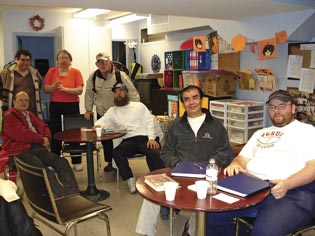 When fire struck a Toronto neighbourhood, members of The Warehouse leapt into action.
When fire struck a Toronto neighbourhood, members of The Warehouse leapt into action.
Are we a church?†asks Lieutenant Ron Farr, corps officer at The Warehouse mission in Toronto’s inner city. “Not in the normal way of thinking. We engage the community and knock down barriers for people who are not always welcome at other churches. If they want to come in, stinking and unshaven, they are welcome. If they want to sit for five minutes and then walk out, that’s fine. And if they just want a meal, that’s OK, too. We bring the gospel but don’t put any limitations on it. People come as they are.â€
“The Warehouse is a place of acceptance, love and hope, where the Holy Spirit is present,†says Brenda Wootten, director of Florence Booth House. “There is no social status, no pretense there. It’s all about being part of the family of God.â€
In January 2001, Ron Farr became a chaplain at The Gateway, a 108-bed shelter and drop-in centre in the downtown core of Toronto. Neither Ron nor his wife, Linda, were strangers to the inner city. For 15 years, Linda worked as a front-line worker at the Yonge Street Mission while Ron volunteered his services as a chaplain and teacher.
Part of Farr’s work as a chaplain was to walk the streets and connect with people experiencing homelessness. “In my travels,†he relates, “the Lord led me to a downtown corner. When I got there, I felt the Holy Spirit say to me, ‘There is work to be done here.’ †Farr realized that God was calling him to plant a church in the downtown core.
“I noticed that when men left homeless shelters for rooming-house life, they often became socially and spiritually isolated,†says Farr. “Six months to a year later, many came back into the system and the rehabilitation process had to begin anew. I wanted to provide a place where they could find stability and community.â€
Looking for a location for his new church, Farr approached Toronto Community Housing (TCH) in 2004 and was offered a former garment factory-a raw-girdered skeleton, without any amenities. TCH invested $150,000 in renovations and The Warehouse was up and running.
Rather than impose solutions, Farr asked the community what they thought was missing. When people suggested a breakfast program, Farr agreed, but told them that they would have to be active participants. Every Saturday morning, more than 80 people are fed by community members who prepare, serve and clean up. The Warehouse soon added a literacy program, Friday evening musical jam sessions and a resource network where people can look for work or housing. “These events are supervised by us,†notes Farr, “but they are really run by the community.â€
Last April, right after The Warehouse became an official church plant of The Salvation Army, an incident occurred that exemplified what the ministry was about. A rooming house in the area burned down, leaving 11 people homeless.
The Farrs were unavailable. Ron was en route to a Salvation Army integrated-mission conference in Winnipeg, while Linda was having eye surgery. Acting on their own initiative, Warehouse members opened their doors to the victims, contacted the Army’s emergency and disaster relief services and helped relocate the dispossessed through Toronto Community Housing.
Farr was informed of the fire only after his plane touched down in Winnipeg. “My first reaction was, I have to get on a plane and get back there,†he remembers. “But I was told, ‘Don’t worry, it’s all under control.’ They did it all themselves.â€
Back at the conference, Farr gave delegates an up-to-the-minute account of what was happening in Toronto. “What a success story,†he recalls. “God’s people took the initiative to reach out to their community in a time of crisis. While we were in the conference talking about integrated mission, they were living it.â€
by Ken Ramstead, Associate Editor, Faith & Friends
Reprinted from Salvationist August 2007
(Pictured above are Warehouse members)